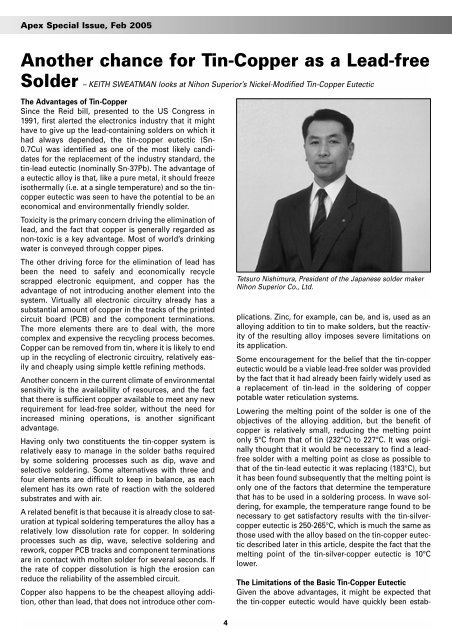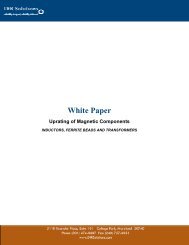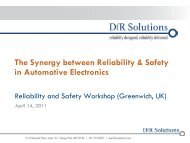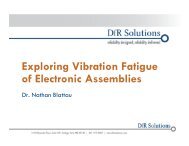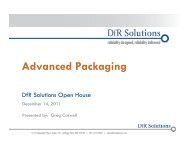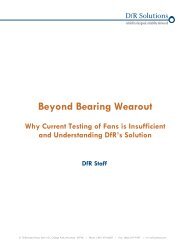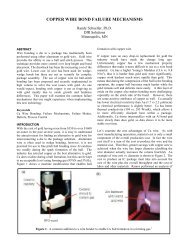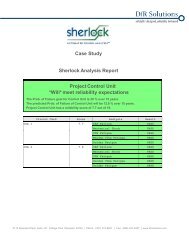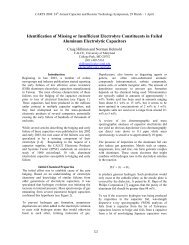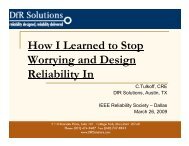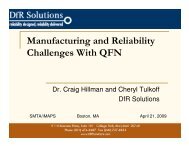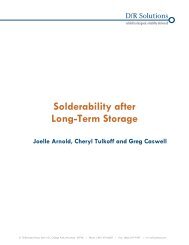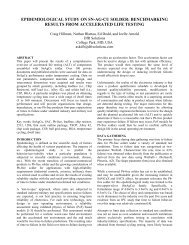Another chance for Tin-Copper as a Lead-free Solder - DfR Solutions
Another chance for Tin-Copper as a Lead-free Solder - DfR Solutions
Another chance for Tin-Copper as a Lead-free Solder - DfR Solutions
You also want an ePaper? Increase the reach of your titles
YUMPU automatically turns print PDFs into web optimized ePapers that Google loves.
Apex Special Issue, Feb 2005<br />
<strong>Another</strong> <strong>chance</strong> <strong>for</strong> <strong>Tin</strong>-<strong>Copper</strong> <strong>as</strong> a <strong>Lead</strong>-<strong>free</strong><br />
<strong>Solder</strong> – KEITH SWEATMAN looks at Nihon Superior’s Nickel-Modified <strong>Tin</strong>-<strong>Copper</strong> Eutectic<br />
4<br />
Tetsuro Nishimura, President of the Japanese solder maker<br />
Nihon Superior Co., Ltd.<br />
The Advantages of <strong>Tin</strong>-<strong>Copper</strong><br />
Since the Reid bill, presented to the US Congress in<br />
1991, first alerted the electronics industry that it might<br />
have to give up the lead-containing solders on which it<br />
had always depended, the tin-copper eutectic (Sn-<br />
0.7Cu) w<strong>as</strong> identified <strong>as</strong> one of the most likely candidates<br />
<strong>for</strong> the replacement of the industry standard, the<br />
tin-lead eutectic (nominally Sn-37Pb). The advantage of<br />
a eutectic alloy is that, like a pure metal, it should <strong>free</strong>ze<br />
isothermally (i.e. at a single temperature) and so the tincopper<br />
eutectic w<strong>as</strong> seen to have the potential to be an<br />
economical and environmentally friendly solder.<br />
Toxicity is the primary concern driving the elimination of<br />
lead, and the fact that copper is generally regarded <strong>as</strong><br />
non-toxic is a key advantage. Most of world’s drinking<br />
water is conveyed through copper pipes.<br />
The other driving <strong>for</strong>ce <strong>for</strong> the elimination of lead h<strong>as</strong><br />
been the need to safely and economically recycle<br />
scrapped electronic equipment, and copper h<strong>as</strong> the<br />
advantage of not introducing another element into the<br />
system. Virtually all electronic circuitry already h<strong>as</strong> a<br />
substantial amount of copper in the tracks of the printed<br />
circuit board (PCB) and the component terminations.<br />
The more elements there are to deal with, the more<br />
complex and expensive the recycling process becomes.<br />
<strong>Copper</strong> can be removed from tin, where it is likely to end<br />
up in the recycling of electronic circuitry, relatively e<strong>as</strong>ily<br />
and cheaply using simple kettle refining methods.<br />
<strong>Another</strong> concern in the current climate of environmental<br />
sensitivity is the availability of resources, and the fact<br />
that there is sufficient copper available to meet any new<br />
requirement <strong>for</strong> lead-<strong>free</strong> solder, without the need <strong>for</strong><br />
incre<strong>as</strong>ed mining operations, is another significant<br />
advantage.<br />
Having only two constituents the tin-copper system is<br />
relatively e<strong>as</strong>y to manage in the solder baths required<br />
by some soldering processes such <strong>as</strong> dip, wave and<br />
selective soldering. Some alternatives with three and<br />
four elements are difficult to keep in balance, <strong>as</strong> each<br />
element h<strong>as</strong> its own rate of reaction with the soldered<br />
substrates and with air.<br />
A related benefit is that because it is already close to saturation<br />
at typical soldering temperatures the alloy h<strong>as</strong> a<br />
relatively low dissolution rate <strong>for</strong> copper. In soldering<br />
processes such <strong>as</strong> dip, wave, selective soldering and<br />
rework, copper PCB tracks and component terminations<br />
are in contact with molten solder <strong>for</strong> several seconds. If<br />
the rate of copper dissolution is high the erosion can<br />
reduce the reliability of the <strong>as</strong>sembled circuit.<br />
<strong>Copper</strong> also happens to be the cheapest alloying addition,<br />
other than lead, that does not introduce other complications.<br />
Zinc, <strong>for</strong> example, can be, and is, used <strong>as</strong> an<br />
alloying addition to tin to make solders, but the reactivity<br />
of the resulting alloy imposes severe limitations on<br />
its application.<br />
Some encouragement <strong>for</strong> the belief that the tin-copper<br />
eutectic would be a viable lead-<strong>free</strong> solder w<strong>as</strong> provided<br />
by the fact that it had already been fairly widely used <strong>as</strong><br />
a replacement of tin-lead in the soldering of copper<br />
potable water reticulation systems.<br />
Lowering the melting point of the solder is one of the<br />
objectives of the alloying addition, but the benefit of<br />
copper is relatively small, reducing the melting point<br />
only 5°C from that of tin (232°C) to 227°C. It w<strong>as</strong> originally<br />
thought that it would be necessary to find a lead<strong>free</strong><br />
solder with a melting point <strong>as</strong> close <strong>as</strong> possible to<br />
that of the tin-lead eutectic it w<strong>as</strong> replacing (183°C), but<br />
it h<strong>as</strong> been found subsequently that the melting point is<br />
only one of the factors that determine the temperature<br />
that h<strong>as</strong> to be used in a soldering process. In wave soldering,<br />
<strong>for</strong> example, the temperature range found to be<br />
necessary to get satisfactory results with the tin-silvercopper<br />
eutectic is 250-265°C, which is much the same <strong>as</strong><br />
those used with the alloy b<strong>as</strong>ed on the tin-copper eutectic<br />
described later in this article, despite the fact that the<br />
melting point of the tin-silver-copper eutectic is 10°C<br />
lower.<br />
The Limitations of the B<strong>as</strong>ic <strong>Tin</strong>-<strong>Copper</strong> Eutectic<br />
Given the above advantages, it might be expected that<br />
the tin-copper eutectic would have quickly been estab-
Apex Special Issue, Feb 2005<br />
lished <strong>as</strong> the preferred lead-<strong>free</strong> solder. Indeed it w<strong>as</strong><br />
included, with the tin-silver-copper eutectic, <strong>as</strong> one of the<br />
lead-<strong>free</strong> solders recommended by industry consortia in<br />
Europe (IDEALS) and America (NEMI) although, because<br />
of its higher melting point, only <strong>for</strong> wave soldering.<br />
However, the results with SnCu0.7 were generally unacceptable,<br />
showing poor joint fillet shape and the high<br />
temperatures/times needed to effect soldering caused<br />
deterioration of the board materials.<br />
At the temperatures that PCB components can tolerate,<br />
the alloy lacks the fluidity necessary in wave soldering<br />
<strong>for</strong> filling the plated- through holes of PCBs and the<br />
draining of excess solder from the "bridges" between<br />
adjacent joints, that otherwise create short circuits. And<br />
when it solidified the tin-0.7% copper alloy did not look<br />
like the eutectic it w<strong>as</strong> supposed to be, but had a coarse<br />
cracked surface with the outline of primary _-tin dendrites<br />
apparent in the surface. In an attempt to get better<br />
fluidity the solder bath temperature w<strong>as</strong> incre<strong>as</strong>ed but,<br />
that resulted in damage to board materials. And even<br />
then the quality of the soldering w<strong>as</strong> unsatisfactory.<br />
In trials with the tin-copper eutectic in the Hot Air <strong>Solder</strong><br />
Levelling (HASL) of PCBs, another major market <strong>for</strong> solder,<br />
similar problems were encountered and it w<strong>as</strong><br />
widely believed that the change to lead-<strong>free</strong> solder<br />
would mark the end of HASL <strong>as</strong> a PCB finish.<br />
The consequence of these un<strong>for</strong>tunate experiences with<br />
the tin-copper eutectic w<strong>as</strong> that it became widely<br />
Diary<br />
APEX 2005<br />
22-24 February 2005<br />
Printed Circuits Expo and the<br />
Designers Summit<br />
Anaheim Convention Center<br />
Anaheim, CA, USA<br />
IPC - Association Connecting<br />
Electronics Industries<br />
E-mail: shows@ipc.org<br />
www.GoIPCShows.org<br />
Electronica & Productronica China<br />
15 – 17 March 2005<br />
Shanghai New International Expo<br />
Centre SNIEC, Shanghai, China,<br />
www.global-elecronics.net<br />
NEPCON China / EMT China,<br />
12 – 15 April 2005<br />
Shanghai Everbright convention &<br />
Exhibition Center, Shanghai, China,<br />
www.nepconchina.com<br />
IPC / JEDEC<br />
18 - 21 April 2005<br />
8th Conference <strong>Lead</strong> Free Components<br />
& Assemblies, San Jose, CA, USA,<br />
alexandracurtis@ipc.org<br />
ElectronicAmeric<strong>as</strong><br />
25 – 29 April 2005<br />
Anhembi Park, Sao Paulo, Brazil,<br />
www.global-electronics.net<br />
NEPCON Korea<br />
26 – 28 April 2005<br />
COEX Korea Exhibition Center, Seoul,<br />
Korea<br />
www.smtpcb.org<br />
NEPCON Tahiland<br />
5 – 8 May 2005<br />
Bangkok International Trade &<br />
Exhibition Centre,<br />
www.nepconthailand.com<br />
5
Apex Special Issue, Feb 2005<br />
accepted that the tin-silver-copper eutectic, or alloys<br />
close to that composition, would become the main<br />
replacement <strong>for</strong> tin-lead solder in the coming lead-<strong>free</strong><br />
era. <strong>Tin</strong>-copper w<strong>as</strong> relegated to some low technology<br />
dipping process where cost w<strong>as</strong> the major consideration.<br />
Turning the <strong>Tin</strong>-<strong>Copper</strong> Eutectic into a User-Friendly<br />
<strong>Solder</strong><br />
Given the potential advantages of the tin-copper eutectic<br />
there should have been a strong incentive to improve<br />
its properties. However, most of the electronics industry<br />
and its suppliers seemed content to accept that the tinsilver-copper<br />
eutectic would be the standard lead-<strong>free</strong><br />
solder and concentrated on exploring variants within<br />
the constraints of the patents that already covered that<br />
system.<br />
Tetsuro Nishimura, now President of the Japanese solder<br />
maker Nihon Superior Co., Ltd, w<strong>as</strong>, however, convinced<br />
that it should be possible to improve the properties<br />
of tin-copper eutectic. As a metallurgist Tetsuro<br />
knew that there were examples of the properties of<br />
eutectics being improved by minor ternary additions to<br />
create industrially important alloys. He there<strong>for</strong>e began<br />
a systematic study of possible additions to the tin-copper<br />
eutectic.<br />
One of the ph<strong>as</strong>es in the tin-copper eutectic is an intermetallic,<br />
Cu6Sn5, with some distinctly non-metallic<br />
characteristics, and the fact that the microstructure of<br />
the tin-copper eutectic contains a lot of primary _-tin,<br />
which in theory should not be present, suggests that<br />
solidification w<strong>as</strong> being inhibited by difficulty in nucleating<br />
the intermetallic ph<strong>as</strong>e. If this could be improved,<br />
the result might be a much more user friendly solder. A<br />
search of known tin-b<strong>as</strong>ed intermetallics revealed a<br />
nickel-tin intermetallic, Ni3Sn2, which h<strong>as</strong> the same<br />
close packed hexagonal structure <strong>as</strong> Cu6Sn5 and almost<br />
the same lattice constants, suggesting that nickel atoms<br />
could be incorporated fairly e<strong>as</strong>ily into Cu6Sn5. The<br />
resulting disturbance to the crystal structure might facilitate<br />
the earlier nucleation necessary <strong>for</strong> the alloy to<br />
behave <strong>as</strong> a true eutectic.<br />
This hypothesis w<strong>as</strong> confirmed with the discovery that<br />
an addition of less than 0.1% nickel dramatically<br />
changed the appearance of the <strong>as</strong>-c<strong>as</strong>t alloy. When in<br />
1999 this modified alloy w<strong>as</strong> tried in a wave soldering<br />
line, on which an unsuccessful attempt had been made<br />
to solder VCR boards with the unmodified tin-copper<br />
eutectic, the effect w<strong>as</strong> dramatic. The incidence of<br />
bridges fell to a level comparable with that obtained<br />
with tin-lead solder, good soldering could be achieved at<br />
a temperature of 255°C and, <strong>as</strong> a bonus, the solder fillet<br />
w<strong>as</strong> smooth and bright, disproving the widespread<br />
belief that lead-<strong>free</strong> solder joints are inevitably dull and<br />
grainy.<br />
This development is protected by patents in Japan and<br />
most other developed countries<br />
Sn-0.7Cu<br />
Sn-0.7Cu+Ni<br />
Effect of a controlled addition of nickel on the appearance of<br />
the tin-0.7% copper alloy<br />
News of this alloy, offered to the market by Nihon<br />
Superior under the brand name "SN100C" quickly<br />
spread and by the end of 2004 there were more than 600<br />
wave solder machines in more than 16 countries around<br />
the world using this alloy in commercial production with<br />
more machines being commissioned every month.<br />
A similar dramatic difference w<strong>as</strong> noted when in 2002<br />
this nickel-modified tin-copper eutectic w<strong>as</strong> tried in a<br />
vertical HASL machine. Good results could be obtained<br />
at a temperature of 265°C, only a little higher than had<br />
been used with tin-lead. Hole clearance and bridge<br />
elimination w<strong>as</strong> good and the finish w<strong>as</strong> smooth, bright<br />
and shiny. Similar results were obtained in subsequent<br />
trials on horizontal HASL lines and there are now more<br />
than 20 lines around the world using this process commercially<br />
with more lines being commissioned every<br />
month. An unexpected bonus is that the uni<strong>for</strong>mity of<br />
the nickel-modified tin-copper eutectic HASL finish is<br />
better than typically obtainable with tin-lead solder.<br />
Given that the non-uni<strong>for</strong>mity of the coating thickness<br />
6
Apex Special Issue, Feb 2005<br />
w<strong>as</strong> one of the characteristics that w<strong>as</strong> limiting the<br />
application of HASL to surface mount boards this<br />
improvement should open up new opportunities <strong>for</strong><br />
HASL <strong>as</strong> a PCB finish.<br />
Although initially developed <strong>for</strong> wave soldering, the<br />
nickel-modified tin-copper eutectic also offers promise<br />
in reflow soldering. The melting point is 10°C higher<br />
than that of the tin-silver-copper eutectic that is being<br />
widely promoted <strong>for</strong> this application, but in a good<br />
<strong>for</strong>ced- convection oven the nickel- modified tin-copper<br />
alloy can be reflowed with a profile having a peak temperature<br />
of around 245°C. (A temperature often used <strong>for</strong><br />
the reflow of the tin-silver-copper eutectic.) The same<br />
smooth bright fillets are obtained in reflow <strong>as</strong> in wave<br />
soldering and "SN100C" is being adopted by a number<br />
of companies who prefer to use the same alloy <strong>for</strong> both<br />
reflow and wave soldering.<br />
Other Advantages of the Nickel-Modified <strong>Tin</strong>-<strong>Copper</strong><br />
Eutectic <strong>as</strong> a <strong>Lead</strong>-<strong>free</strong> <strong>Solder</strong><br />
The per<strong>for</strong>mance reported above would by itself be sufficient<br />
to justify the widespread adoption of the nickelmodified<br />
tin-copper eutectic <strong>as</strong> a lead-<strong>free</strong> solder but<br />
there are other advantages that further strengthen the<br />
c<strong>as</strong>e.<br />
In wave soldering, the economics of the process are<br />
greatly affected by dross losses and Nihon Superior’s<br />
nickel-modified tin-copper eutectic h<strong>as</strong> a low dross<br />
rate, typically around half that of tin-3.0% silver-0.5%<br />
copper.<br />
The pot of wave soldering machines h<strong>as</strong> been traditionally<br />
constructed of stainless steel which is resistant<br />
to erosion by tin-lead solder. All the high-tin lead-<strong>free</strong><br />
solders are more aggressive towards stainless steel,<br />
but this seems to be incre<strong>as</strong>ed by the presence of silver<br />
and is further incre<strong>as</strong>ed by the phosphorus that is<br />
commonly added to tin-silver-copper alloys in an<br />
attempt to reduce drossing. The problem is being<br />
addressed by the use of solder baths constructed of<br />
titanium or of stainless steel with erosion-resistant<br />
coatings or surface treatments, but these add to the<br />
cost of the equipment. The nickel-modified tin-copper<br />
eutectic h<strong>as</strong> been found to be much less aggressive<br />
towards stainless steel and many wave soldering<br />
machines using this alloy in production have only plain<br />
stainless steel solder baths.<br />
Reference w<strong>as</strong> made earlier to the erosion of copper<br />
tracks and component terminations by lead-<strong>free</strong> solders.<br />
As well <strong>as</strong> being a reliability issue the eroded copper<br />
contaminates the solder bath. If the rate of erosion<br />
is low enough, <strong>as</strong> it is with the nickel-modified tin-copper<br />
eutectic, the copper content can be kept within specification<br />
by the use of a top-up alloy with a lower copper<br />
content. However, if the rate of erosion is too great, that<br />
technique is not sufficient and part of the solder bath<br />
h<strong>as</strong> to be removed periodically, often monthly, and<br />
replaced by copper-<strong>free</strong> solder to keep the composition<br />
within specification.<br />
<strong>Solder</strong> consumption is also affected by the amount of<br />
solder in each joint. The high fluidity of the nickel-modified<br />
tin-copper eutectic usually results in the cl<strong>as</strong>sical<br />
concave fillets. By contr<strong>as</strong>t the tin-silver-copper alloy fillets<br />
tend to be convex and, over the millions of joints<br />
produced each year on a typical line, the extra solder<br />
can be significant.<br />
The above factors all contribute to the cost of running a<br />
wave soldering line and comparisons on parallel lines<br />
over a year indicate that the cost of running a line with<br />
the nickel-modified tin-copper eutectic is typically at<br />
le<strong>as</strong>t half that of a similar line using the tin-3.0% silver-<br />
0.5%copper alloy.<br />
The Market Choice<br />
In the Japanese electronics industry, already about 40%<br />
converted to lead-<strong>free</strong>, Nihon Superior’s "SN100C" h<strong>as</strong><br />
captured a substantial and growing share of the market.<br />
In Europe, which is still less than 10% converted, the<br />
alloy h<strong>as</strong> captured an even larger share of the lead-<strong>free</strong><br />
wave soldering market and virtually all of the lead-<strong>free</strong><br />
HASL market. And it is in Europe that the nickel-modified<br />
tin-copper eutectic h<strong>as</strong> established a position in the<br />
reflow market. The American market is still in the very<br />
early stages of conversion to lead-<strong>free</strong> but, despite the<br />
heavy promotion of the tin-silver-copper alloys there is<br />
strong interest in Nihon Superior’s nickel-modified tincopper<br />
eutectic which is already being reflected in adoption<br />
<strong>for</strong> commercial production. Usage in other Asian<br />
countries reflects the choices in the Japanese, European<br />
and American markets <strong>for</strong> which much of the production<br />
is done and many of the 600+ lines running the<br />
Nihon Superior alloy are located in countries such <strong>as</strong><br />
China, Thailand, Malaysia and Indonesia.<br />
The Nihon Superior development of a nickel modification<br />
process gives the tin-copper eutectic the <strong>chance</strong> of<br />
establishing its rightful place <strong>as</strong> one of the main solders<br />
<strong>for</strong> electronic <strong>as</strong>sembly in the coming lead-<strong>free</strong> era.<br />
Nihon Superior SN100C products<br />
7


